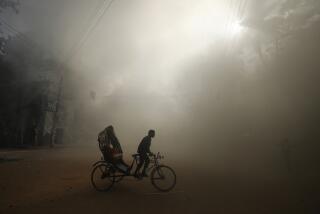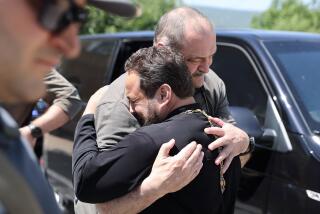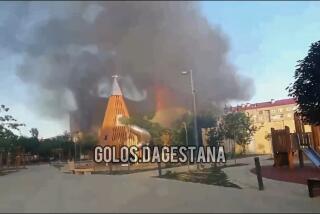Troops Battle Mobs in Soviet Asian Republic
- Share via
MOSCOW — Soviet security forces battled throughout Wednesday against rioting mobs in the Central Asian city of Dushanbe in an effort to restore order there and end the country’s latest, and some of its fiercest, anti-government violence.
Despite the deployment of more troops to Dushanbe, the capital of Soviet republic of Tadzhikistan, and tougher measures to enforce the state of emergency there, the situation continued to deteriorate throughout the day, the official Soviet news agency Tass reported, and government forces had not yet regained full control of the city.
Armed with firebombs and bottles of acid, the rioters for the third day attacked the headquarters of the Tadzhikistan Communist Party, demanding the resignation of the regional party leadership, Tass said, suggesting that an attempt to seize power was under way.
The rioters also began assaulting Russians and other non-Tadzhiks on the streets and in their homes, according to Tass and other Soviet news media reports. Various ethnic groups reportedly began forming “self-defense detachments,” largely composed of veterans of the Afghan war, to protect their communities.
In Moscow, President Mikhail S. Gorbachev, harshly criticizing the rioters, called for stricter enforcement of the law.
“The nation’s destiny and the safety of our citizens is at stake,” Gorbachev told the Supreme Soviet, the country’s Parliament. “We must do everything to put out the fire.
“We should crack down on those who, under the slogans of ethnic revival, draw people into a fight for their ambitions and selfish goals. This is a kind of chain reaction accompanied by an orgy of ethnic revival that draws people into it.”
Gorbachev called in his speech for new laws to curb the ethnic violence that has plagued his reform effort over the past two years.
“The events in Dushanbe, where the flame has spilled over from Baku, speak of the great danger of inter-ethnic violence,” he said, referring to the attacks last month by Azerbaijanis on Armenians in Baku and the subsequent efforts of the government to restore order.
Anatoly I. Lukyanov, the first vice president, said the new Supreme Soviet session will consider draft laws against instigating ethnic violence as well as other legislation on the introduction of states of emergency and the use of troops in civil disturbances.
The lawmakers will also consider new legislation that makes the Soviet Union a more federal system, giving every major ethnic group a great deal of autonomy as the relationship between the central government and the constituent republics is defined.
Armored vehicles, including tanks, were patrolling the streets under the state of emergency and the 10 p.m.-to-6 a.m. curfew, and the firing of automatic weapons could be heard over the telephone during calls to several government departments and newspaper offices in the city.
The troops reportedly opened fire several times on groups of rioters and looters, killing as many as eight people Wednesday, according to reports from opposition groups in Dushanbe. Correspondents for state radio and television said they had seen the bodies, still lying in the street, of some of those killed.
But the report of more fatalities was rejected by Communist Party and government officials, who put the total deaths over three days of clashes at 11 or 12.
They also denied as “totally unfounded” reports on Soviet television and Radio Moscow that 37 people had been killed in the first two days of clashes.
The troops began regrouping late Wednesday, pulling back from many of their positions on the major thoroughfares of Dushanbe and positioning themselves around major government buildings. Commanding officers told Soviet journalists that the maneuver was “normal” in such situations, but it was welcomed by opposition activists who saw it as a conciliatory gesture before the funerals of those killed in the earlier clashes.
There were also contradictory reports on the political situation, reflecting not only the confusion in the streets but the uncertainty about the ability of the Tadzhikistan Communist Party there to reassert its control.
Tass and Soviet television reported that the Tadzhikistan party’s Central Committee held an emergency meeting Wednesday to debate the situation and ended by confirming its support for the present leadership, including the party’s first secretary, Kahkar Makhkamov, who had earlier offered his resignation.
But journalists in Dushanbe said that Makhkamov had quit, along with Tadzhikistan President Gaibnazar Pallayev, and the republic’s premier, Izatullo Khayeyev, and through their resignations managed to ease the confrontation between the rioters and security forces.
The reported resignations brought cheers from the crowd outside the party’s Central Committee building.
Tass earlier Wednesday described the battle between the protesters and troops in Dushanbe.
“Militants have been making attempts to reach the Tadzhik party headquarters since this morning,,” the agency reported. “Crowds threw gasoline bombs, bottles with sulfuric acid and stones at the troops blocking the building’s entrances.”
The rioting was touched off by rumors that Armenian refugees fleeing strife-torn Baku, Azerbaijan, would get preferential treatment and be assigned scarce new housing.
Even when this proved to be false, the idea lingered on that Tadzhiks are not masters in their own land and that the government is a Russian or Soviet creation.
Dushanbe residents said that the problems there have deeper roots--high unemployment and an upsurge of Islamic fundamentalism among young people.
“If you cannot run the republic,” ran one of the anti-government slogans, “leave it to the clergy.”
More to Read
Sign up for Essential California
The most important California stories and recommendations in your inbox every morning.
You may occasionally receive promotional content from the Los Angeles Times.













